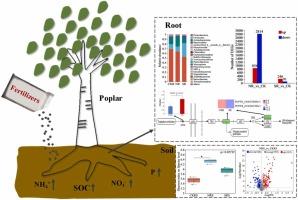尿素和复混肥对杨树根际土壤的影响机理比较
IF 6.2
1区 农林科学
Q1 AGRICULTURAL ENGINEERING
引用次数: 0
摘要
杨树人工林的集约经营依赖于氮肥的施用,以保证杨树的快速生长。弄清两种氮源驱动根际养分循环的生物学机制差异,是优化人工林氮肥施用策略的关键前提。在此基础上,采用元素分析、高通量测序、转录组和代谢组等方法,研究了杨树和根际土壤微生物组和代谢功能对尿素和复混肥的响应。结果表明,施用尿素显著提高了土壤铵态氮(NH4+)和有机碳(SOC)含量,增强了脲酶和纤维素酶活性,强化了碳氮耦合。这些条件丰富了变形杆菌,可能是通过基质驱动的选择,有利于具有氮同化和纤维素降解能力的分类群。相比之下,复合肥有利于硝酸盐(NO3−)的积累,刺激酸性磷酸酶活性,促进磷的动员,丰富放线菌。两种肥料均增加了微生物α多样性,诱导了微生物β多样性分化。功能分析显示,尿素促进了根的半胱氨酸代谢,并重建了半乳糖代谢。复合肥下调了生长素分解代谢基因,促进了生长素在根系的积累。这些发现表明,尿素和复合肥形成了不同的微生物功能网络。尿素优化氮碳快速周转,而复合肥提高磷的生物利用度。这为杨树人工林施肥管理提供了机制依据。本文章由计算机程序翻译,如有差异,请以英文原文为准。

Contrasting mechanisms of poplar and rhizosphere soil influenced by urea and compound fertilizer
The intensive management of poplar plantation depended on nitrogen fertilizer to ensure rapid growth. It is a key prerequisite to optimize the application strategy of nitrogen fertilizer in plantation to clarify the biological mechanism difference of rhizosphere nutrient cycling driven by two nitrogen sources. Based on this, elemental analysis, high-throughput sequencing, transcriptome and metabolome were used to characterize the response of microbiome and metabolic function in poplar and rhizosphere soil to urea and compound fertilizers. The results showed that urea application significantly elevated ammonium (NH4+) and soil organic carbon (SOC) content, enhancing urease and cellobiase activities to intensify carbon-nitrogen coupling. These conditions enriched Proteobacteria, likely through substrate-driven selection favoring taxa with nitrogen assimilation and cellulose degradation capabilities. In contrast, compound fertilizer prioritized nitrate (NO3−) accumulation and stimulated acid phosphatase activity, promoting phosphorus mobilization and enriching Actinobacteria. Both fertilizers increased microbial α-diversity and induced β-diversity divergence. Functional profiling revealed that urea promoted cysteine metabolism and re-established galactose metabolism in roots. Compound fertilizer down-regulated the auxin catabolism gene and promoted the accumulation of auxin in roots. These findings demonstrated that urea and compound fertilizer created distinct microbial functional networks. Urea optimizes rapid nitrogen-carbon turnover, whereas compound fertilizer enhances phosphorus bioavailability. This providing a mechanistic basis for fertilizer-specific management in poplar plantations.
求助全文
通过发布文献求助,成功后即可免费获取论文全文。
去求助
来源期刊

Industrial Crops and Products
农林科学-农业工程
CiteScore
9.50
自引率
8.50%
发文量
1518
审稿时长
43 days
期刊介绍:
Industrial Crops and Products is an International Journal publishing academic and industrial research on industrial (defined as non-food/non-feed) crops and products. Papers concern both crop-oriented and bio-based materials from crops-oriented research, and should be of interest to an international audience, hypothesis driven, and where comparisons are made statistics performed.
 求助内容:
求助内容: 应助结果提醒方式:
应助结果提醒方式:


